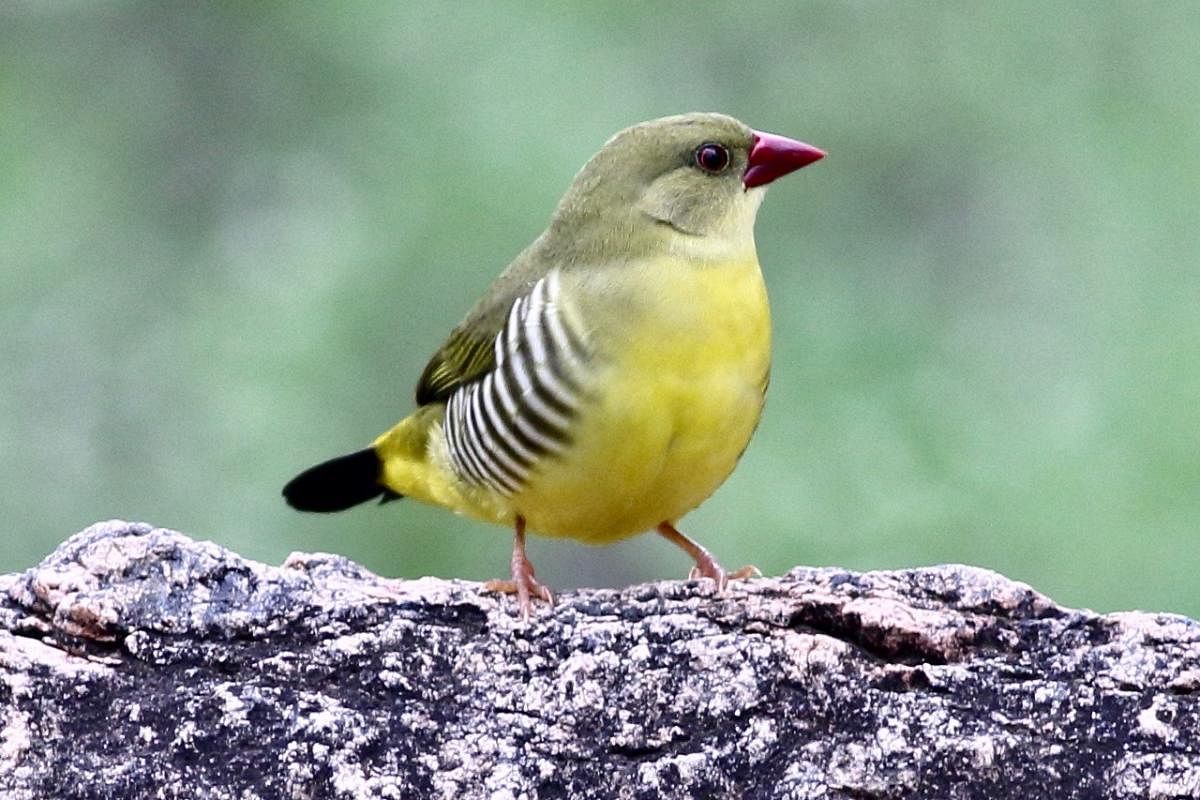
Eight kilometres from Mount Abu, a hill-station in southern Rajasthan, a pockmarked road perilously hugs and winds its way across hillsides covered with Kachnar and Mandar trees to the villages of Oriya and Achalgarh. Not far from these villages stands Gurushikhar, the highest peak in the Aravalli ranges, which rises some 5,650 ft and is home to an ancient temple and a cave.
While this ancient area, situated in the Aravallis, features in various sacred Indian scriptures, and is renowned for its pilgrimage and tourist sights, not much is known about it being home to a rare, spectacularly coloured little bird.
Among the 200-odd species of birds found in Mount Abu Wildlife Sanctuary are five species of munias including the endemic and prized green munia which can be frequently spotted on the hillsides of Mount Abu.
Known by their local name in the hills of Mount Abu, the Harias (translating to the green ones), the globally threatened green munias or green avadavats are exquisitely coloured birds and have a loud high-pitched call making them a much sought-after songbird.
The word 'avadavat' is thought to be a corruption of 'Ahmedabad', historically known to be a thriving bird bazaar and a hub for the caged bird trade. Paradoxically, while they are classed as ‘rare’, illegal trade of these birds continues to flourish. Since these birds move in large flocks, capturing them is easier and illegal trading is more lucrative. Green munias are categorised 'vulnerable' by the International Union for Conservation of Nature (IUCN), and are listed in Schedule IV of the Wildlife Protection Act making hunting, trapping or trade illegal, a punishable offence.
Conservation initiative
Since 2017, habitat restoration work has progressed at a declared and restricted 'Protected Biodiversity Area', which has involved the plantation of native tree species and the controlled management of invasive lantana and parthenium.
So far, over a hundred species of suitable trees have been planted and ever since being declared a 'plantation zone', it has stopped suffering from overgrazing – results of which are already visible in the appearance of grasslands, comprising native wildflowers and flora. While lantana and Mauritius thorn present challenges, the advocacy to indiscriminately remove thick bush cover either mechanically or biologically has been carefully managed at the protected site to safeguard the natural nesting habitat of munias.
The conservation efforts also include rainwater harvesting, waste collection and most importantly, vigilance to curb environmental violations around Oriya and Achalgarh.
The overall reduction in anthropological activities at the protected area has seen an increase in flock sizes. The sight of green munias feeding communally alongside white-throated munias (silverbills) and scaly-breasted munias has become a common sight all through the summer and monsoon months. On a lucky day, flocks of 50 or more birds have been spotted. Zones designated as ‘protected areas’ and strict vigilance have allowed for regular sightings of this attractive bird.
Recent observations have documented that cosmos and crown flowers are the favourites for munias during the seed production stage of the plants.
“It is truly wonderful to see so many green munias at one place. The plantation work has been commendable. The effort could be used as a model to reinvigorate the forests of Mount Abu and provide a safe habitat for these birds”, Gajendra Singh Khimsar, former Forest Minister of Rajasthan remarked on a recent visit to the protected area.
Overcoming roadblocks
Unfortunately, the textbook approach of involving the wider local community has, in this case, been unsuccessful. The conservation efforts have been hampered by local opposition and illegal encroachments.
While the risk from trappers remains ever-present, the major threats are habitat alteration, destruction and pesticide and chemical fertiliser use on local farms. Unmanaged tourism has led to environmental degradation across the declared eco-sensitive zone. Loud music echoes around the hillsides; while relatively untouched habitats are being altered by increasing traffic, deforestation and encroachment.
The future for green munias looks bleak unless conservation efforts are stepped up. Much awareness needs to be generated among the populations of Oriya and Achalgarh, which have become ‘prime’ viewing locations.
A shift towards introducing eco-tourism is urgently required to safeguard the existence of this globally endangered species.
While the green munia populations continue to decline across the country, the species must be protected with greater urgency and by drawing inspiration from initial signs of population increase as part of this conservation initiative.
The significance of safeguarding the habitat of a rare, endemic species in a rapidly degrading environment is the need of the hour. Research and observational work at the protected site will assist in the creation of a comprehensive database to better assist conservation efforts.
(The author has been undertaking conservation and habitat restoration work in Mount Abu since 2017)
